Typical values at TA = +25°C with nominal supplies. Default conditions: TX input data rate = 491.52MSPS, fDAC = 11796.48MSPS (24x interpolation), interleave mode, 1st Nyquist zone output, PLL clock mode with fREF = 491.52MHz, AOUT = –1dBFS, DSA = 0dB, Sin(x)/x enabled, DSA calibrated
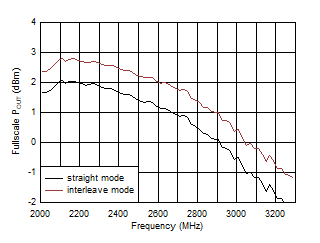
| Including PCB and cable losses, Aout = -0.5dBFS, DSA = 0, 2.6GHz matching |
|
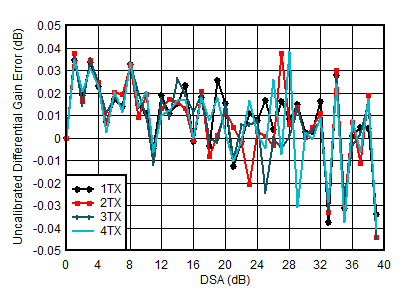
| fDAC = 8847.36MSPS, straight mode, matching at 2.6GHz |
| Differential Gain Error = POUT(DSA Setting – 1) – POUT(DSA Setting) + 1 |
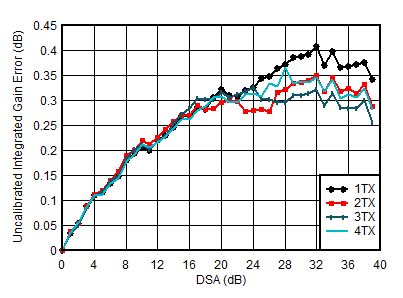
| fDAC = 8847.36MSPS, straight mode, matching at 2.6GHz |
| Integrated Gain Error = POUT(DSA Setting) – POUT(DSA Setting = 0) + (DSA Setting) |
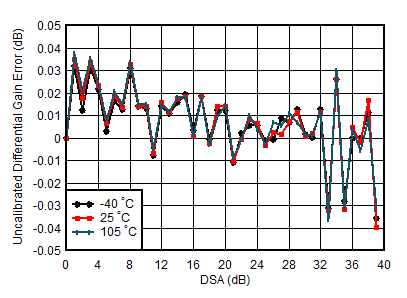
| fDAC = 8847.36MSPS, straight mode,
matching at 2.6GHz, channel with the median variation
over DSA setting at 25°C |
| Differential Gain Error = POUT(DSA Setting – 1) – POUT(DSA Setting) + 1 |
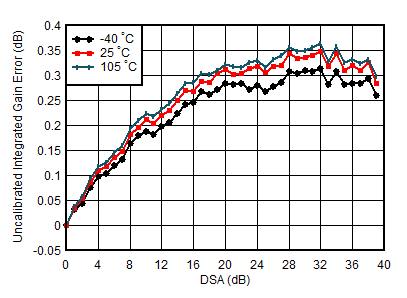
| fDAC = 8847.36MSPS, straight mode,
matching at 2.6GHz, channel with the median variation
over DSA setting at 25°C |
| Integrated Gain Error = POUT(DSA Setting) – POUT(DSA Setting = 0) + (DSA Setting) |
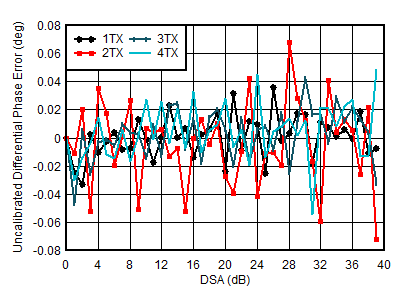
| fDAC = 8847.36MSPS, straight mode,
matching at 2.6GHz |
| Differential Phase Error = PhaseOUT(DSA Setting – 1) – PhaseOUT(DSA Setting) |
|
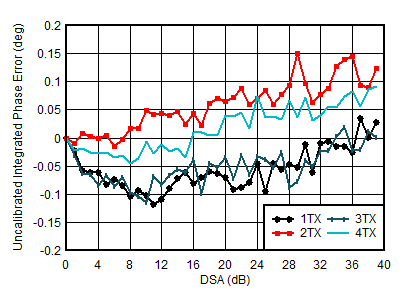
| fDAC = 8847.36MSPS, straight mode,
matching at 2.6GHz |
| Integrated Phase Error = Phase(DSA Setting) – Phase(DSA Setting = 0) |
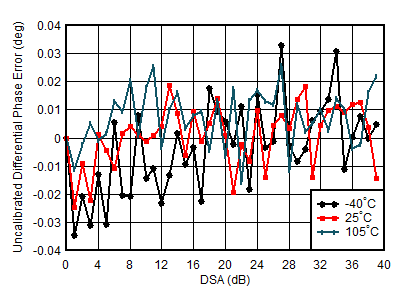
| fDAC = 8847.36MSPS, straight mode,
matching at 2.6GHz, channel with the median variation
over DSA setting at 25°C |
| Differential Phase Error = PhaseOUT(DSA Setting – 1) – PhaseOUT(DSA Setting) |
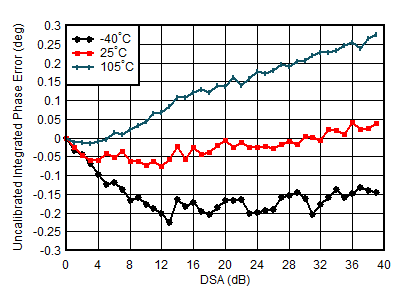
| fDAC = 8847.36MSPS, straight mode,
matching at 2.6GHz, channel with the medium variation
over DSA setting at 25°C |
| Integrated Phase Error = Phase(DSA Setting) – Phase(DSA Setting = 0) |
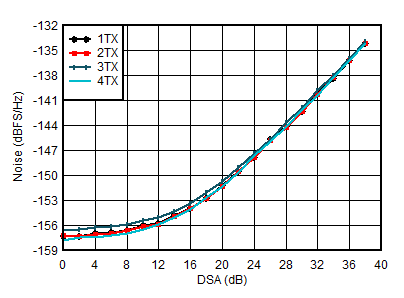
| fDAC = 8847.36MSPS, straight mode,
matching at 2.6GHz, POUT = –13 dBFS |
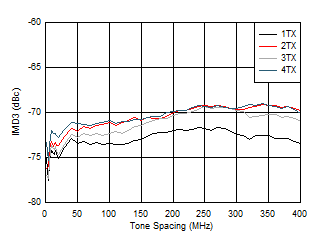
| fDAC = 8847.36MSPS, straight mode,
fCENTER = 2.6GHz, matching at 2.6GHz, –13
dBFS each tone |
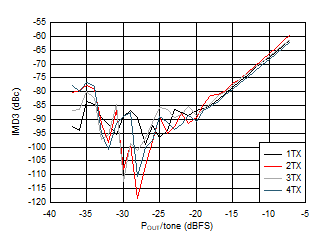
| fDAC = 8847.36MSPS, straight mode,
fCENTER = 2.6GHz, fSPACING =
20 MHz, matching at 2.6GHz |
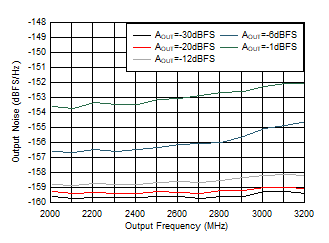
| Matching at 2.6GHz, Single tone, fDAC = 11.79648GSPS, interleave mode, 40-MHz offset |
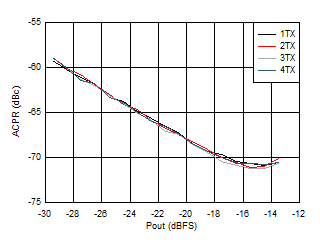
| Matching at 2.6GHz, single carrier 20MHz BW
TM1.1 LTE |
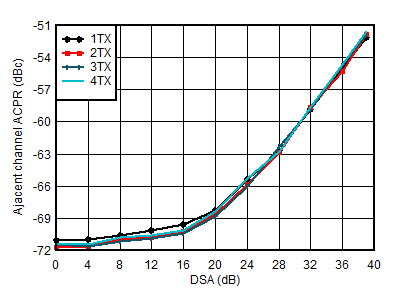
| Matching at 2.6GHz, single carrier 20MHz BW
TM1.1 LTE |

| Matching at 2.6GHz, single carrier 20MHz BW
TM1.1 LTE |
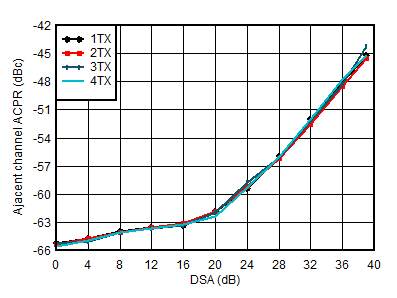
| Matching at 2.6GHz, single carrier 100MHz BW
TM1.1 NR |
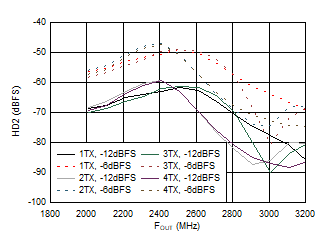
| Matching at 2.6GHz, fDAC =
11.79648GSPS, interleave mode, normalized to output
power at harmonic frequency |
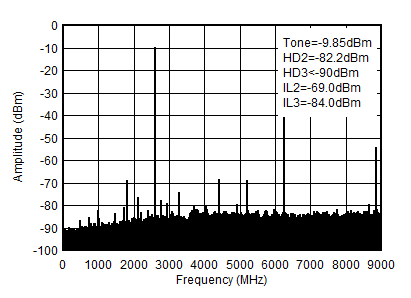
| fDAC = 8847.36MSPS, straight mode,
2.6GHz matching, includes PCB and cable losses. ILn =
fS/n ± fOUT and is due to
mixing with digital clocks. |
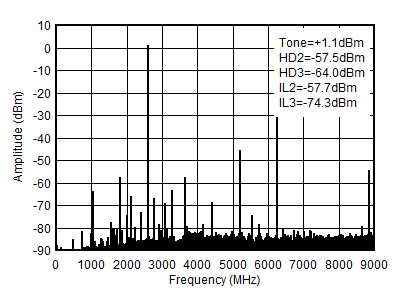
| fDAC = 8847.36MSPS, straight mode,
2.6GHz matching, includes PCB and cable losses. ILn =
fS/n ± fOUT and is due to
mixing with digital clocks. |
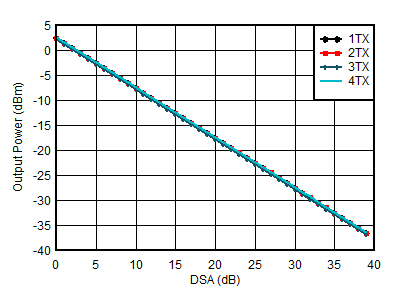
| fDAC = 8847.36MSPS, Aout = -0.5dBFS, matching 2.6GHz |
|
|
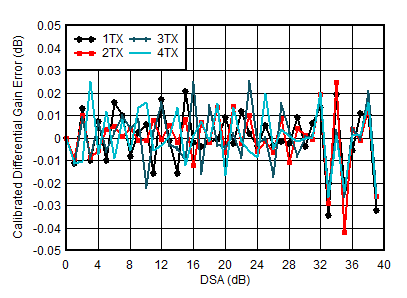
| fDAC = 8847.36MSPS, straight mode, matching at 2.6GHz |
| Differential Gain Error = POUT(DSA Setting – 1) – POUT(DSA Setting) + 1 |
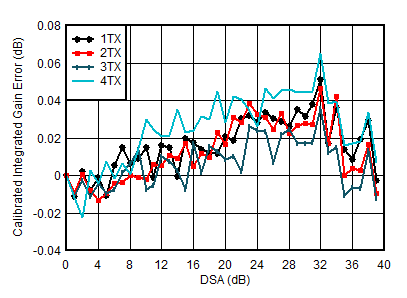
| fDAC = 8847.36MSPS, straight mode,
matching at 2.6GHz |
| Integrated Gain Error = POUT(DSA Setting) – POUT(DSA Setting = 0) + (DSA Setting) |
|
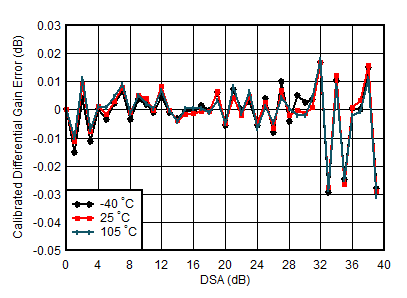
| fDAC = 8847.36MSPS, straight mode,
matching at 2.6GHz, channel with the median variation
over DSA setting at 25°C |
| Differential Gain Error = POUT(DSA Setting – 1) – POUT(DSA Setting) + 1 |
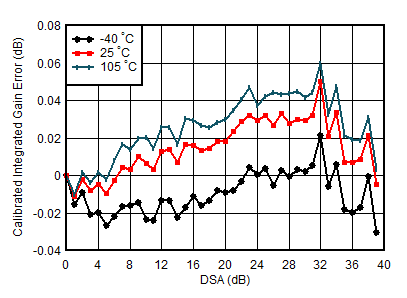
| fDAC = 8847.36MSPS, straight mode,
matching at 2.6GHz, channel with the median variation
over DSA setting at 25°C |
| Integrated Gain Error = POUT(DSA Setting) – POUT(DSA Setting = 0) + (DSA Setting) |
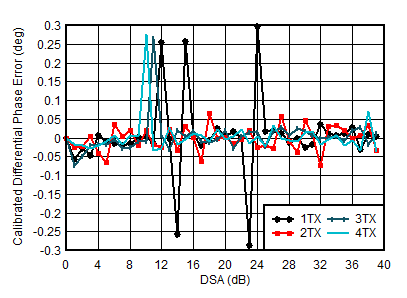
| fDAC = 8847.36MSPS, straight mode,
matching at 2.6GHz |
| Differential Phase Error = PhaseOUT(DSA Setting – 1) – PhaseOUT(DSA Setting) |
| Phase DNL spike may occur at any DSA setting. |
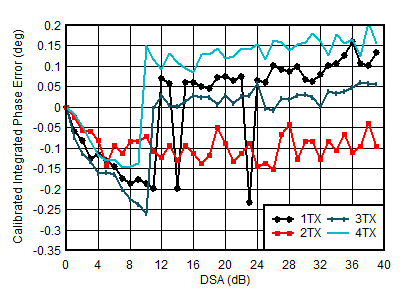
| fDAC = 8847.36MSPS, straight mode,
matching at 2.6GHz |
| Integrated Phase Error = Phase(DSA Setting) – Phase(DSA Setting = 0) |
|
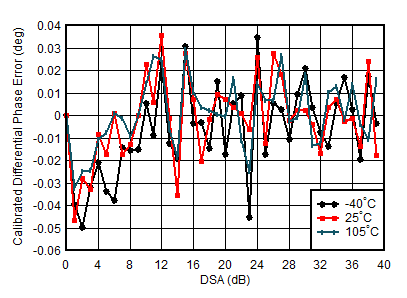
| fDAC = 8847.36MSPS, straight mode,
matching at 2.6GHz, channel with the median variation
over DSA setting at 25°C |
| Differential Phase Error = PhaseOUT(DSA Setting – 1) – PhaseOUT(DSA Setting) |
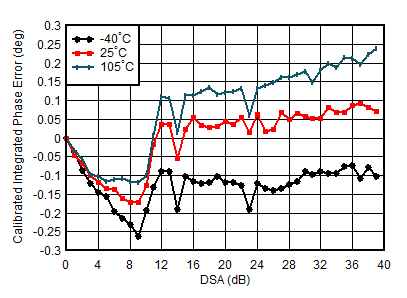
| fDAC = 8847.36MSPS, straight mode,
matching at 2.6GHz, channel with the median variation
over DSA setting at 25°C |
| Integrated Phase Error = Phase(DSA Setting) – Phase(DSA Setting = 0) |
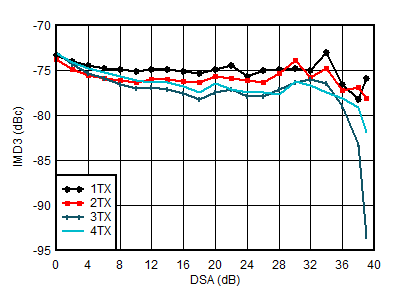
| fDAC = 8847.36MSPS, straight mode,
fCENTER = 2.6GHz, matching at 2.6GHz, –13
dBFS each tone |
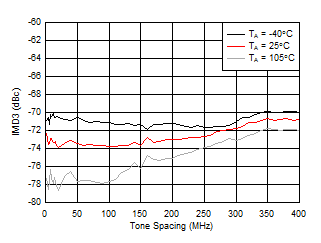
| fDAC = 8847.36MSPS, straight mode,
fCENTER = 2.6GHz, matching at 2.6GHz, –13
dBFS each tone, worst channel. |
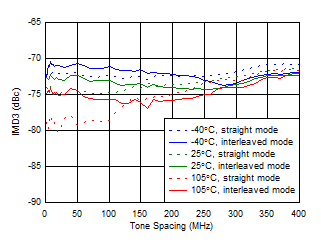
| fDAC = 8847.36MSPS, straight mode,
fCENTER = 2.6GHz, matching at 2.6GHz, –13
dBFS each tone |
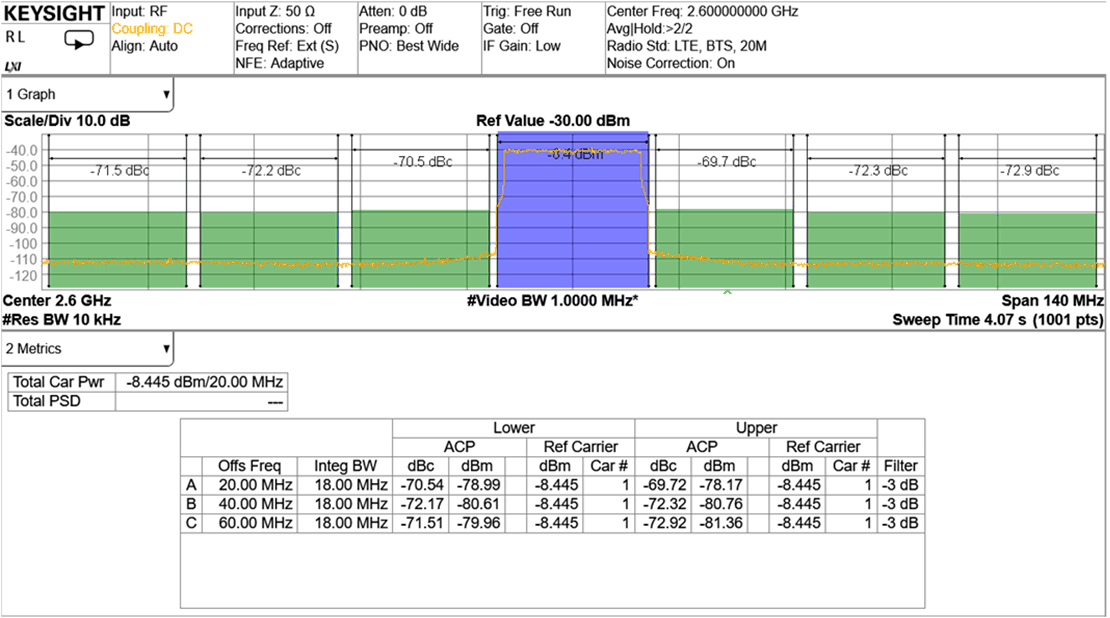
| TM1.1, POUT_RMS = –13dBFS |
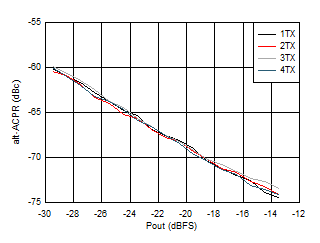
| Matching at 2.6GHz, single carrier 20MHz BW
TM1.1 LTE |
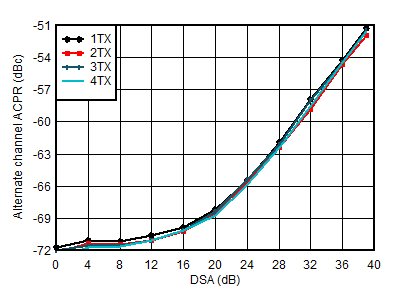
| Matching at 2.6GHz, single carrier 20MHz BW
TM1.1 LTE |

| Matching at 2.6GHz, single carrier 20MHz BW
TM1.1 LTE |
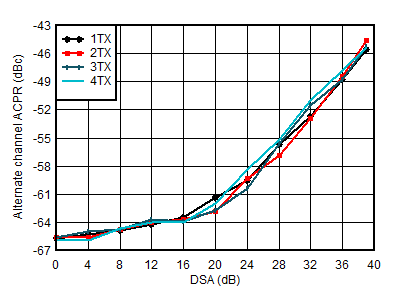
| Matching at 2.6GHz, single carrier 100MHz BW
TM1.1 NR |
|
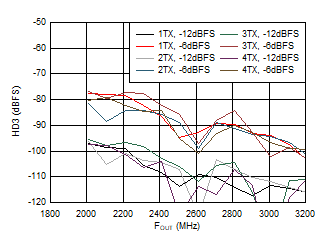
| Matching at 2.6GHz, fDAC =
11.79648GSPS, interleave mode, normalized to output
power at harmonic frequency |
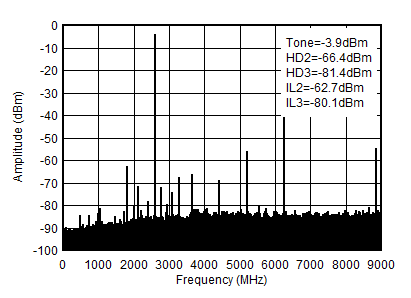
| fDAC = 8847.36MSPS, straight mode,
2.6GHz matching, includes PCB and cable losses. ILn =
fS/n ± fOUT and is due to
mixing with digital clocks. |
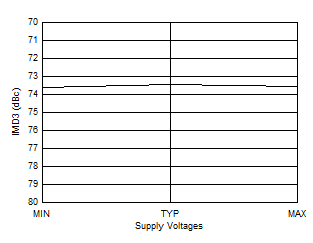
| fDAC = 11796.48MSPS, interleave
mode, 2.6GHz matching. 40MHz offset from tone. Output
Power = –13dBFS. All supplies simultaneously at MIN,
TYP, or MAX voltages. |







































